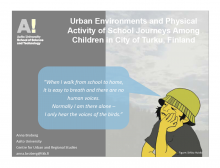We are pleased to announce an exciting new alliance between Active Living Research and GP RED to co-host and coordinate...
Urban Environments and Physical Activity of School Journeys Among Children in City of Turku, Finland

Presentation at the 2010 Active Living Research Annual Conference
Background:
In the beginning of 2000, 20% of young people in Finland were overweight, and in adolescence, overweight and obesity have tripled in 30 years. It has been assumed that one reason for this serious public health issue is decreased physical activity (PA). The studies made in the USA and in the UK indicate that traveling to school by car has increased. Similar observations have been made in Finland. Reducing car use and increasing walking to and from school has many health and environmental benefits. The assumption is that active school transport can be an important source of children’s physical activity and promote healthy body weights.
There is growing evidence that built environment affects the PA among children. Kyttä (2003) has analyzed the role of physical and material environment in promoting children’s development and wellbeing. The results showed that two essential criteria for child-friendly environments were the possibility for independent outdoor mobility and the environmental affordances (possibilities and incentives to act). Current technical developments in geoinformatics (GIS) have opened up new possibilities to study the relationship between children and their environment. We will present a new soft geographic information system methodology, softGIS that has the potential to engage communities in designing activity friendly environments by allowing the children to share their knowledge of their living environment with urban planners and researchers.
Objectives:
The objectives were to examine the relationships between built environment and children’s self-reported activity on school journeys and their independent mobility, and to find out how experiences of different urban environments relate to children’s perceived health. The practical objective was to build a participatory evaluation tool to gather experiential knowledge to help the planners and other authorities of the city of Turku.
Methods:
The data was collected with softGISchildren method combining Internet-maps with questionnaires. Children used the internet interface to mark their home and daily routes to school attached with questions concerning school journeys. They also located places that were functionally, emotionally or socially meaningful, and answered questionnaire concerning their perceived health and well-being.
With GIS techniques, the perceptions of the residents were combined with register-based data concerning the physical structure of the city. Buffering technique was utilized to analyze the physical qualities and the density of respondents’ immediate surroundings: e.g. amount of green space or housing units within 500 meter buffers surrounding respondents’ homes. Distances between localized affordances and homes were also calculated. The combined data were analyzed using mainly logistic regression.
Target group of the study consisted of 5th and 7th graders living in Turku, Finland. Turku consists of different living environments: the city centre is very dense and urban, whereas the distant suburban areas are almost rural. 1837 children from 54 schools answered the questionnaire and marked over 12 000 affordances on the map.
Results:
The perceived environmental and health-related data obtained from children, and the objective geographical data revealed significant associations between the physical characteristics of settings, children’s experiences of outdoor environments and their perceived health. Urban density was positively related to the school journeys made walking or cycling. Density was also positively associated with shorter distance to mapped affordances and the likeability of affordances. Walking or cycling to school was significantly (negatively) associated with the probability of overweight. The emotional experiences of environment were also related to the perceived health and the presence of daily health problems. The only urban structure variable that had direct association with well-being and health variables was the amount of green structure around child’s home.
Conclusions:
The findings are in line with recent research concerning the health-promotive qualities of urban structure. Urban sprawl is shown to be related to lower level of PA and higher risk of overweight. Compact urban structure with high neighbourhood accessibility is associated with higher probability of walking and cycling to school, errands and work and relating health outcomes. Our findings show that (rather) dense urban structure can have child-friendly characteristics and promote physically active school journeys.
The results and part of the raw data were delivered to the local planners. Research combining soft experiential knowledge with hard register data was able to produce meaningful results for planning practices and decision-making processes with regard to how the physical environment affects the behavior and experiences of the inhabitants. At best, these methods and results can build a bridge between ‘soft’ and ‘hard’ environmental knowledge, between the experiences of children and the strivings of urban planners.
The softGIS methodology allows also more detailed analysis of urban environments that are child- and activity friendly, and these will be handled in future articles.
Reference
Kyttä, M (2003). Children in outdoor contexts. Affordances and independent mobility in the assessment of environmental child friendliness. HUT/CURS. Publication A 28.
Support:
The research was funded by the Finnish Funding Agency for Technology and Innovation, and the Ministry of Education.
STAY UP TO DATE
RECENTLY ADDED TOOLS & RESOURCES
MOVE! A BLOG ABOUT ACTIVE LIVING
The "Active Living Conference" aims to break down research and practice silos and...







